Commodities the Return To Inflation? / Commodities / Commodities Trading
 The headline in this Thursday’s Financial Timesreads: “Commodities prices hit highest point since 2014”.
The headline in this Thursday’s Financial Timesreads: “Commodities prices hit highest point since 2014”.
The FT articlebegins: “The Bloomberg Commodity Spot Index,which tracks price of 22 raw materials, has hit its highest level since 2014when the oil market price crash started.”
A small problem mightbe that the Bloomberg Commodity Spot Index does not include Energy or PreciousMetals, which are in other Bloomberg indexes. In fact, in the BloombergCommodity Spot Index is a grouping of Raw Industrials and Food Stuffs. The RawIndustrials includes burlap, copper scrap, cotton, hides, lead scrap,print cloth, rosin, rubber, steel scrap, tallow, tin, wool tops, and zinc.Foodstuffs include butter, cocoa beans, corn, cottonseed oil, hogs, lard,steers, sugar, and wheat.
The FT reference tothe year 2014 was to the crash of Oil prices due to the collapse of the financialsystem, which in turn caused the entire basket of commodities to fall. Thearticle’s clear inference, however, is not about commodity prices because mediaknows that people have a tough time referring to commodities unless it’s thefuel for their vehicles and homes or the food on their table.
Obviously, withtypical emotion-hitting headlines, the Financial Times was poking at thepublic’s soft spot, inflation.
Now that Crude Oilprices have returned to the 60’s in the past month for both WTI and Brent,doubled from the 30’s and below in 1Q2016, the entire commodities narrative ischanging. While the 2017 Energy rally was an alarming development in manyquarters, particularly for wealth managers and traders who were short ormissing the train, it seems that media has used it as an excuse to concernpeople that inflation is on the way.
Even the FederalReserve Bank members and central bankers of several countries are now talkingup inflation. We are sure this publicly-sensitive topic will be a prominent discussionat the next meeting of the G-20 finance ministers and central bankers – simplybecause it has more to do with their need to raise rates to normalized levels,so they can regain monetary policy control of the global financial system.
Given the G-20’slatest involvement with inflation, should we as wealth managers really beconcerned about it, and if so what types of inflation should we be considering?
Are we talkingproducer prices or consumer prices for example? Are consumer prices the wholebasket or just what is called the core basket, which excludes food and energycosts, deemed to be too volatile for sensitive eyes? Are we even talkingconsumer prices or people’s wages, which could be inflating more or less? And,in what country? Might we be considering America or Argentina or possiblyVenezuela? There’s quite a range.
We’re sure most of uscould agree that if commodity prices rise high enough for long enough therewould be a reason for us to be having an inflation problem. Today, however, mostof us would agree that, while inflation does exist, as it always does to somedegree, there is no inflation problem, at least not in most of the advancedeconomies of the world.
There will be aninflation problem sometime in our future, we know, but for that there will bejust one of two catalysts: (a) a major international war, or, (b) more likely,if only because of its inevitability, an overshoot by central banks inwithdrawing liquidity from capital markets through excessive selling ofover-priced securities to its member banks thereby sucking up money supply theysay is too abundant. The latter problem i.e., over-doing policy implementation,we know, has been a repeat offense in cyclical terms. Then, when too littlemoney chases the goods and services the world really needs -- and it’s notbitcoin -- ergo there is inflation – in one form and/or in one country oranother.
There is so much wecould discuss if the issue here was indeed inflation, so let’s do ourselves afavor and just stick to commodity prices, leaving the media to its usualpractice of planting false flags.
Energy is the world’smost important commodity and unless and until crude oil is somehow replaced,the global economy absolutely needs increasing amounts of it. Withoutsufficient crude oil, economies shrivel, and capital markets collapse. That isa fact. What is arguable is that, at crude oil prices that have been too lowfor too long, the oil and gas industry is financially unsustainable.Insufficient prices have not permitted sufficient capital expenditures toreplace known reserves as they have been depleting in normal use as the globaleconomy has been growing at rates of +2% to more than +3% on an annual basis.
From the Summer of2016, after the subject became a contentious one, we argued that sustainableeconomics of the Oil & Gas industry required the prices of West TexasIntermediate and Brent to rise from about $45/bbl (WTI) at the time to $65/bbl.However, skeptics then threw every possible argument against us such as alternativeenergy, shale oil technology, electric vehicles, and the like. We argued simplythat, while all of that contained much truth, in the real world theconventional Oil & Gas industry was the 800-pound gorilla in terms of ourenergy supply.
To us, these negativearguments were like a 1-hour bar chart overlaid on the more important 1-yearchart. In terms of wave theory, they were focused on ripples instead of thetide. They were never going to look forward a quarter or a year, but were infact using personal agenda-supporting arguments that extended the time horizon5 to 10 years past what is important to us as wealth managers.
Through productionagreements among the majority of Oil & Gas producing nations, the market isfinally approaching normalization, i.e., back to $65 sustainable Oil economics.With a few dips and turns, we’ll have it. Long-term demand and supply is beingrebalanced, which brings us to the most important point about commodities,demand-supply economics will endure while the actions of financial marketplayers, when extreme, will sooner or later produce unintended consequences.
As wealth managers, unless our names are Vanguard, Goldman and the like,our time and resources for study are limited. We need to use some helpfulanalytical tools and then we need to think, to apply our skills, knowledge, andexperience.
Given such practical constraints, when it comes to decision-making withregard to prices of commodities and derivative instruments, we find that oneparticular investigative tool is helpful. The Commodity Channel Index is ameasure of the variation of a commodity price from its statisticalmean/statistical average. This fits within our understanding that market pricesrise and fall in trends and cycles, always reverting to the mean.
The CCI technical indicator available to all of us is a price oscillatorthat oscillates between high levels and low levels, always seeking what wouldbe a normal level based on long-term supply-demand economics.
| Commodity | Month | Recent |
Energy | Brent Oil | 18.mars | 67.80 |
| CarbonEmissions | 18.mars | 7.75 |
| Crude Oil WTI | 18.févr | 61.61 |
| Gasoline RBOB | 18.févr | 1.80 |
| Heating Oil | 18.févr | 2.07 |
| London GasOil | 18.janv | 607.50 |
| Natural Gas | 18.févr | 2.79 |
Softs | Lumber | 18.janv | 455.50 |
| Orange Juice | 18.mars | 138.50 |
| US Cocoa | 18.mars | 1896.50 |
| US Coffee C | 18.mars | 129.17 |
| US Cotton #2 | 18.mars | 78.67 |
| US Sugar #11 | 18.mars | 15.23 |
Meats | Feeder Cattle | 18.janv | 147.57 |
| Lean Hogs | 18.févr | 71.05 |
| Live Cattle | 18.févr | 120.80 |
Metals | Aluminum |
| 2213.75 |
| Copper | 18.mars | 3.23 |
| Copper |
| 7123.75 |
| Gold | 18.févr | 1318.30 |
| Lead |
| 2579.25 |
| Nickel |
| 12497.50 |
| Palladium | 18.mars | 1086.30 |
| Platinum | 18.avr | 969.40 |
| Silver | 18.mars | 17.20 |
| Tin |
| 19900.00 |
| Zinc |
| 3366.50 |
Brent
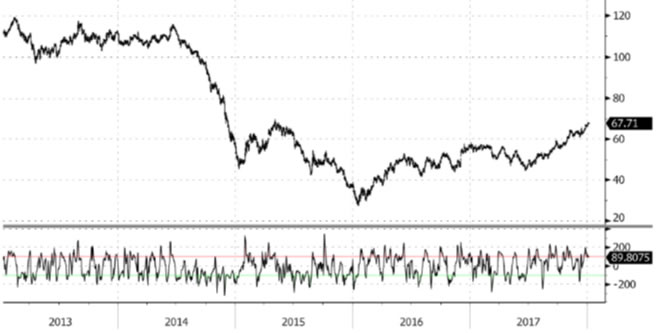
West Texas
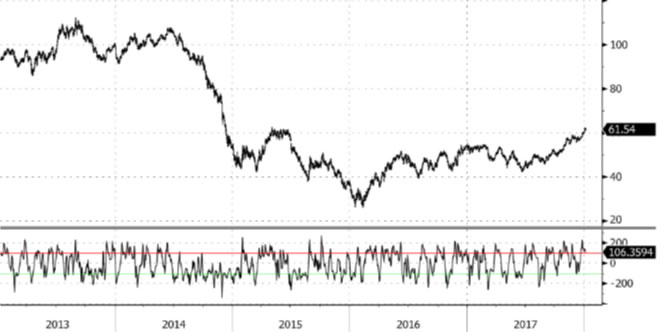
Natural Gas
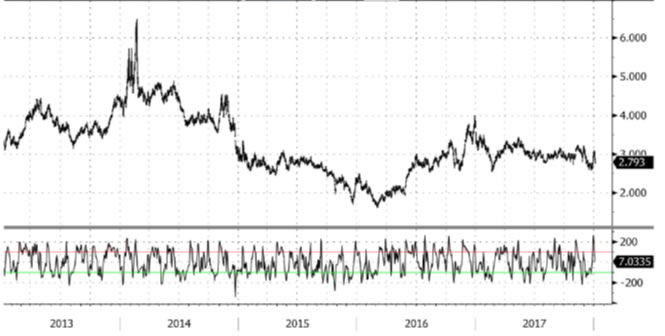
Gold
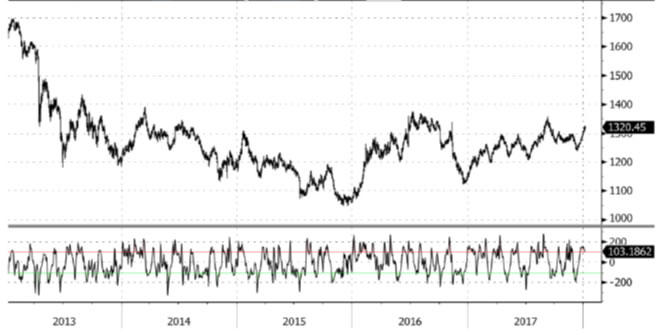
Silver
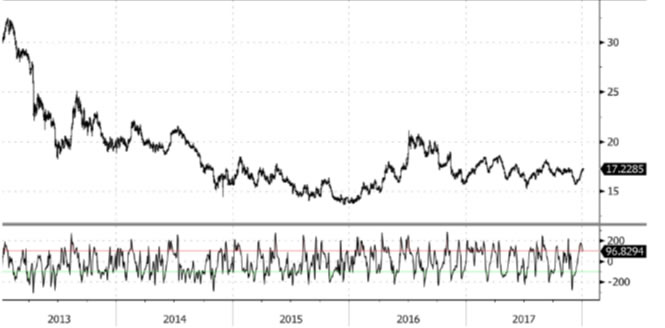
Copper
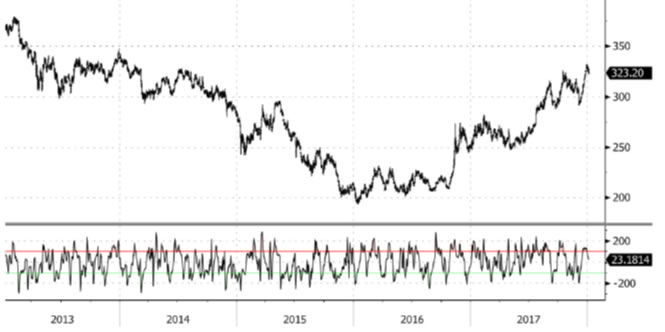
Aluminium
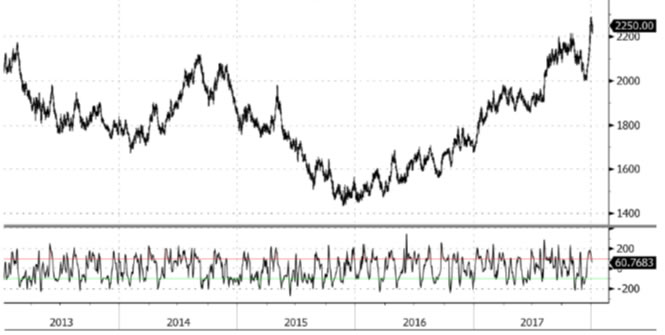
Lead
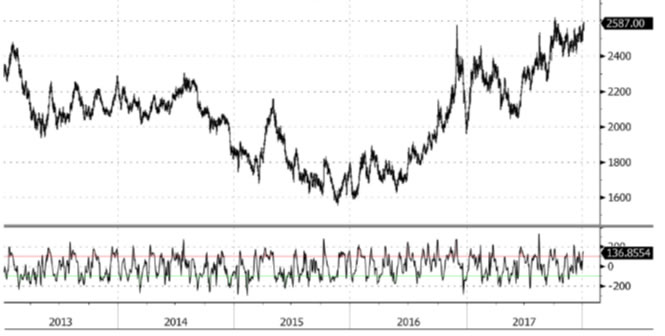
Zinc
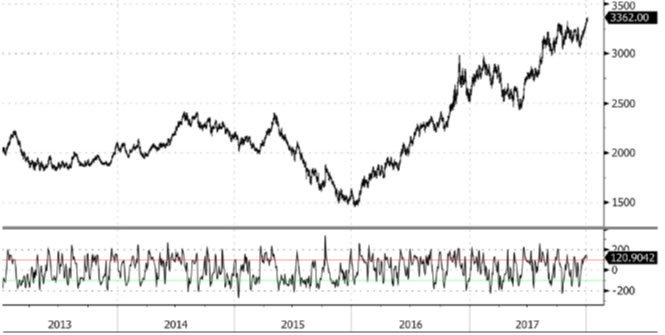
Lumber
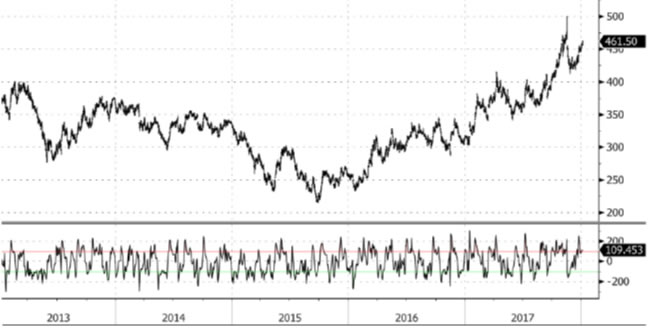
Orange Juice
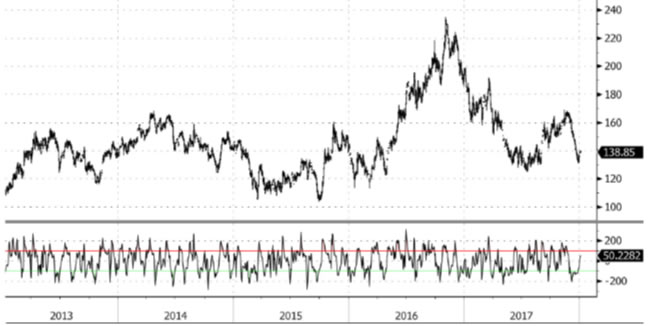
Lean Hogs
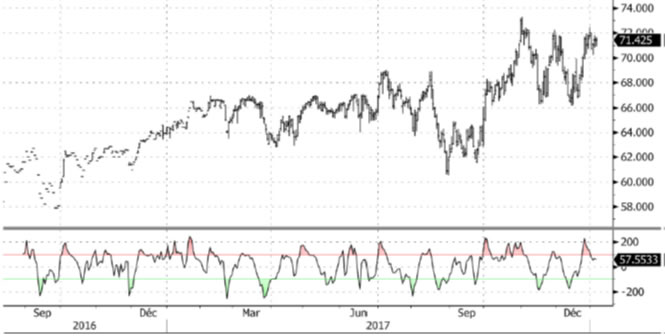
Live Cattle
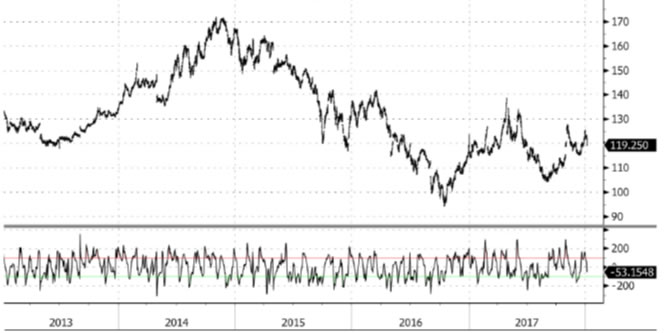
Technically speaking, ifCCI is above +100; then overbought conditions are indicated. IF above +200; animpending market correction i.e., reversion to the mean, is indicated, which isusually a good time to sell, particularly as the CCI falls closer to +100.
Similarly, if CCI is below-100; then oversold conditions are indicated. When below -200; an impendingmarket correction i.e., reversion to the mean, is also indicated, which isusually a good time to buy, particularly as the CCI rises closer to -100.
In practice, for ourNatural Resources Fund portfolio, we study CCI commonality over multiple timeframes such as Monthly, Weekly and Daily data series to give us an overviewperspective of market conditions. When we get to a high-priced market (i.e.,sellers’ market) or a low-priced market (i.e., buyers’ market), we run aproprietary but simple algorithm (CCI, RSI and some other indicators) onintra-daily data series of our invested positions plus watchlist instruments.
Presently, thesecharts are indicative that Energy and Metals are high-priced for their Monthly,Weekly and Daily data series. We call this the Distribution Zone, a time forselling. Back on September 1, 2017, when we started the Natural Resources Fund portfolio, we happened to bein the Accumulation Zone, a time for buying, first for Oil&Gas and then forMetals.
Initially we favoredOil over Gas and Copper. Then we favored Silver over Gold. These are thecommodities and their derivative instruments (i.e., in our case the equities)we accumulated in September. In late December we were taking profits as CCI wasindicating over-bought price levels.
We noted all ourtrades in the Natural Resources Fund portfolio monthly report: for the Oilers,our profits came from Callon (CPE +28.3%), Carrizo (CRZO +41.0%), Devon (DVN+30.7%), Gulfport (GPOR +0.1%), Helmerich & Payne (HP +48.3%), Murphy (MUR+25.2%), Newfield Expl. (NFX +19.1%), Pioneer (PXD +20.7%), and Sanchez (SN+9.3%). We also closed our position in HudBay Minerals (HBM +19.0%). We soldfull positions in all but GPOR, where we sold a 40% position because of nat gasseasonality and the extreme cold in the northern States and Canada over theholiday period. We earlier had bought into weakness, then sold into strength,while taking no losses, so clearly the CCI technical indicator has been auseful tool in our toolbox.
At the end of theday, there are two factors we find important in trading commodity-basedequities: (i) corporate fundamental strength of the underlying instrument, and(ii) technical timing of the underlying commodity price.
Wealth managers, including self-managed traders, areadvised to use this encompassing approach when commodities-related equities areinvolved. Moreover, it pays to ignore the narrative pushed by mainstream mediawho have a raison-d’être quite different than ourselves.
By Williams Market Analytics
http://www.williamsmarketanalytics.com
We provide insightful market analysis and account management founded upon our very successful systematic, disciplined approach to investing. Our investment analysis revolves around two inputs: company valuation and our quantitative, market-based indicators. Learn more about our approach and our strategist.
© 2018 Copyright Williams Market Analytics - All Rights Reserved
Disclaimer: The above is a matter of opinion provided for general information purposes only and is not intended as investment advice. Information and analysis above are derived from sources and utilising methods believed to be reliable, but we cannot accept responsibility for any losses you may incur as a result of this analysis. Individuals should consult with their personal financial advisors.
© 2005-2018 http://www.MarketOracle.co.uk - The Market Oracle is a FREE Daily Financial Markets Analysis & Forecasting online publication.
